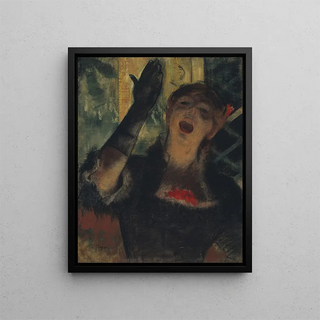Art print Café Singer - Edgar Degas | Art print


View from behind

Frame (optional)
Art print Café Singer - Edgar Degas – Captivating Introduction
In the fascinating world of Impressionist art, Edgar Degas's "Café Singer" stands out for its vibrant atmosphere and its ability to capture the essence of Parisian life at the end of the 19th century. This canvas, which immerses the viewer in the lively ambiance of a café, is a true homage to modernity and the effervescence of society at the time. Observing this scene, one feels invited to immerse oneself in a suspended moment, where the characters seem frozen in a dance of glances and gestures. The art print of this iconic work allows appreciation of the finesse of details and the richness of colors, while offering a glimpse into Degas's creative spirit.
Style and uniqueness of the work
Edgar Degas's style is characterized by a unique approach that combines realism and Impressionism. In "Café Singer," he uses quick, fluid brushstrokes to create a lively and dynamic atmosphere. The figures, though stylized, reveal a deep understanding of human posture and social interactions. The play of light and shadow, as well as the reflections on glasses and shiny surfaces, add an almost tactile dimension to the scene. Degas excels in depicting fleeting moments, capturing life’s instants that seem to escape daily routine. This work, with its warm color palette and balanced compositions, perfectly embodies the quintessence of his style, while offering a reflection on time and memory.
The artist and his influence
Edgar Degas, born in 1834, is one of the major figures of Impressionism, although he often preferred to distance himself from this movement. His fascination with movement, whether it be dancers, horses, or café scenes, reflects a constant search for the very essence of action. Influenced by masters of the past, such as Delacroix and Ingres, Degas forged an artistic language that is uniquely his own. His innovative approach to composition and his ability to play with unexpected angles opened the way for many contemporary and future artists. Exploring various themes, from dance to

Matte finish

View from behind

Frame (optional)
Art print Café Singer - Edgar Degas – Captivating Introduction
In the fascinating world of Impressionist art, Edgar Degas's "Café Singer" stands out for its vibrant atmosphere and its ability to capture the essence of Parisian life at the end of the 19th century. This canvas, which immerses the viewer in the lively ambiance of a café, is a true homage to modernity and the effervescence of society at the time. Observing this scene, one feels invited to immerse oneself in a suspended moment, where the characters seem frozen in a dance of glances and gestures. The art print of this iconic work allows appreciation of the finesse of details and the richness of colors, while offering a glimpse into Degas's creative spirit.
Style and uniqueness of the work
Edgar Degas's style is characterized by a unique approach that combines realism and Impressionism. In "Café Singer," he uses quick, fluid brushstrokes to create a lively and dynamic atmosphere. The figures, though stylized, reveal a deep understanding of human posture and social interactions. The play of light and shadow, as well as the reflections on glasses and shiny surfaces, add an almost tactile dimension to the scene. Degas excels in depicting fleeting moments, capturing life’s instants that seem to escape daily routine. This work, with its warm color palette and balanced compositions, perfectly embodies the quintessence of his style, while offering a reflection on time and memory.
The artist and his influence
Edgar Degas, born in 1834, is one of the major figures of Impressionism, although he often preferred to distance himself from this movement. His fascination with movement, whether it be dancers, horses, or café scenes, reflects a constant search for the very essence of action. Influenced by masters of the past, such as Delacroix and Ingres, Degas forged an artistic language that is uniquely his own. His innovative approach to composition and his ability to play with unexpected angles opened the way for many contemporary and future artists. Exploring various themes, from dance to
12,34 €






